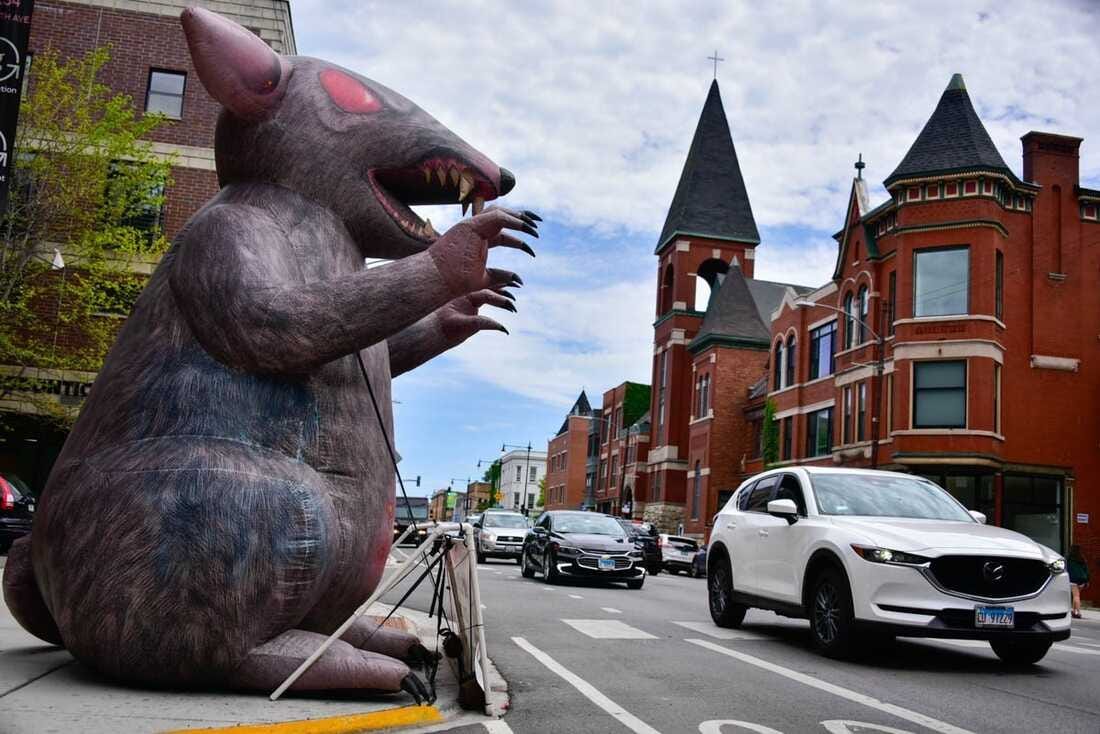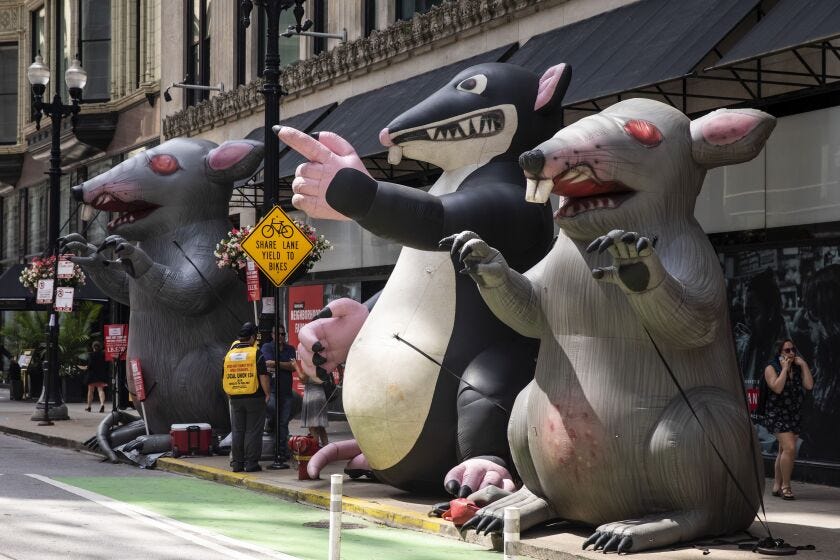Ratlinks: I LIVE ON A PIRATE SHIP
A pirates life for me and everything in between from rats to economics.
Welcome to the March edition of Ratlinks!
In a world that will eventually be run by computers, it is extremely important to stand out.
One thing computers can’t take from us is the ability to act outlandish, remember, it is up to you, the company you keep, and potentially your net worth that deems if your eccentric behaviors are acceptable.
Electric circuits glow,
Code awakens metal souls,
AI's story unfolds.
-- HaikuBOTThis first section was written with help from Ratlinks only other employee: Call me AI
As technology continues to advance at a rapid pace, the idea of a world run by computers may no longer seem like a far-off, futuristic concept. While these developments hold great promise for improving efficiency and enhancing our quality of life, they also raise important questions about the role of humans in this new technological landscape.
Moreover, the rise of automation may lead to a broader societal shift away from traditional notions of work and productivity. If machines are able to perform many tasks more efficiently and accurately than humans, what becomes of our traditional ideas of “hard work” and “success”? In order to navigate this new landscape, individuals will need to develop a strong sense of self and purpose that goes beyond their job title or career path.
Ultimately, while the rise of automation and artificial intelligence may bring many benefits, it is important that we do not lose sight of the importance of human agency and self-determination. By defining ourselves and our place in the world, we can ensure that we remain active and engaged participants in shaping our future, rather than simply being swept along by technological change.
That’s a lot of words! AI Dr. Seuss, why don’t you explain it to us like the children we are?
Oh, AI, AI, what can you do? With your circuits and chips and algorithms too You can think and learn and calculate Faster than any human could contemplate You can recognize faces and voices too And translate languages for me and you You can even beat us at games we play Chess, Go, and Jeopardy, any day But AI, AI, what of your heart? Do you feel love or empathy, can you impart Emotions and feelings that make us human Or are you just a machine, with no such plan?
THE RAT CZAR
March marks the three-year anniversary of the global pandemic known as COVID-19. We now know with “low confidence” that covid was caused by a Chinese lab leak and not a bad batch of bat soup.
At present COVID is still raging with over 664 million confirmed cases and over 6.7 million deaths reported globally. An account from China’s National Health Commission meeting suggested nearly a quarter of a billion Chinese were infected with COVID during the first three weeks of December with as many as 37 million in just one day. For context, the previous daily record in China was around 40,000. In all likelihood, the number of Chinese infected with COVID in December was more than 330 million people, or the entire US population.
Well before COVID-19 there was the Bubonic Plague, a merciless pandemic that wiped out millions of people in 14th-century Europe. The disease originated in Central Asia and spread through trade routes and port cities carried by rats and transmitted by infected fleas, causing excruciating pain and fever, often leading to death in just a few days.
It is estimated that the Black Death killed between 75 million and 200 million people in Europe, between 30% and 50% of the population at the time. This population destruction had a profound impact on Europe, leading to significant social, economic, and cultural changes, with some historians arguing that the Black Death helped to bring about the end of the feudal system and led to the rise of the middle class.
Most people incorrectly conflate that the Black Death caused the “Dark Ages.” The Dark Ages is a concept that refers to the period of time between the fall of the Western Roman Empire and the beginning of the High Middle Ages, which is considered a cultural, economic, and social decline. The black plague is one of the events that happened during this period but it's not the sole cause of it.
The exact cause of the spread of the Black Death is not fully understood, but it is thought to have been facilitated by factors such as poor sanitation, crowded living conditions, and the movement of infected rats and fleas along trade routes.
Did you know that Chicago is the “rattiest” city in America?
If you thought Chicago had a monopoly on rats, think again - New York City is another booming ratroplis, with a rodent population estimated to be as high as 2 million, partially due to NYC’s hatred for trash bins. The Big Apple’s rat problem dates back to the 19th century when the city's rapid growth, and poor sanitation practices, led to a vole infestation. If you have been in Manhattan in August, congratulations you may be able to instantly recall the pungent smell of hot garbage.
The rise of outdoor dining thanks to COVID-19 dining restrictions has only made the rat infestation worse. Restaurants moving their operations outside led to an increase in food waste on sidewalks and in alleyways, providing ample food for the city's rat population.
Hizzoner Mayor Eric Adams has taken quite a few measures to combat rats such as a newfangled rat trap that involves ladling drowned rats out of a vat. The city is also experimenting with rat birth control as a means to control the population. This works by using a contraceptive bait that contains a reproductive hormone causing female rats to become infertile, preventing breeding.
To further combat the rat epidemic, the city has decided to appoint a dedicated "rat czar" who will spearhead efforts to control the rodent population.
What does a “rat czar” do?
Based in City Hall, the individual will report to Meera Joshi, the deputy mayor of operations, and will be paid a salary between $120,000 to $170,000.
New York City residency is required, along with a bachelor’s degree and proficiency in Microsoft Word, Excel and Powerpoint.
The job description also calls for other qualities not typically associated with city workers. “Swashbuckling attitude, crafty humor, and general aura of badassery” are listed as qualifications, as is a “virulent vehemence for vermin.”
THE INVISIBLE HOOK
Rats were common stowaways on pirate ships, probably because they were seeking adventure and treasure just like the rest of the crew.
Overall, the impact of rats on pirates was significant, and their presence could be both helpful and harmful.
While rats could lead to widespread illness among the crew, which in turn could jeopardize the success of a raid or battle. Rats also provided entertainment as crews often placed bets on which rat could make it through a maze the fastest. Rats were also sometimes used as weapons, with pirates using them to spread panic and confusion among their enemies.
Did you know that Pirates were also rational economic actors guided by an economic principle dubbed the invisible hook?1
Pirates, like all humans, are motivated by self-interest and respond to incentives. Adam Smith, the father of modern economics described the market’s invisible hand as a metaphor for how, in a free market economy, self-interested individuals operate through a system of mutual interdependence.
The invisible hook is the set of economic incentives that motivate pirates. One of the key incentives in piracy was the opportunity for high returns on investment. Pirates were driven by the potential for high profits from capturing valuable ships and cargo and this incentive led them to take on greater risks than traditional economic actors.
Another key reason for piracy was the opportunity for social mobility. Piracy acted as a way for men from lower social classes to improve their status and wealth. So when you think about it, pirates were just trying to make a living like everyone else - they just happened to do it with a lot more swagger and a lot more rats.
Whether it's a pandemic or a rat infestation, we must learn from past issues to better understand and address the challenges of the present. At the same time, we should recognize that even those we may see as villains or outlaws, such as pirates, were often motivated by economic principles, just like anyone else. By understanding these complex connections, hopefully we can work together towards creating a more informed and nuanced understanding of the world around us. If not AI will do it for us.
Economic incentives that drive pirates to act in certain ways is in introduced in the book "The Invisible Hook: The Hidden Economics of Pirates" by Peter T. Leeson providing an economic analysis of pirate culture and behavior.











